Platinum & Palladium: The Quiet Power Duo of Industrial Metals
2025-10-22 09:44:08
The Silent Pulse Behind Industrial Metals

When traders think “metals,” gold and silver usually take center stage. But beneath their shine lies a quieter force - platinum and palladium - two industrial powerhouses that quietly drive the global economy from behind the scenes.
They don’t often make headlines, yet they’re essential to everything from clean transportation to industrial manufacturing. These aren’t just metals; they’re functional catalysts in the literal sense. And for traders who use Smart Money Concepts (SMC), they offer hidden opportunities - cyclical plays that unfold away from the noise of gold’s hype or silver’s volatility.
In this feature, we’ll dive into how these metals differ from traditional ones, why industrial and jewelry demand is shifting, and how traders can read their cycles like institutional insiders.
Platinum and Palladium: The Industrial Elite
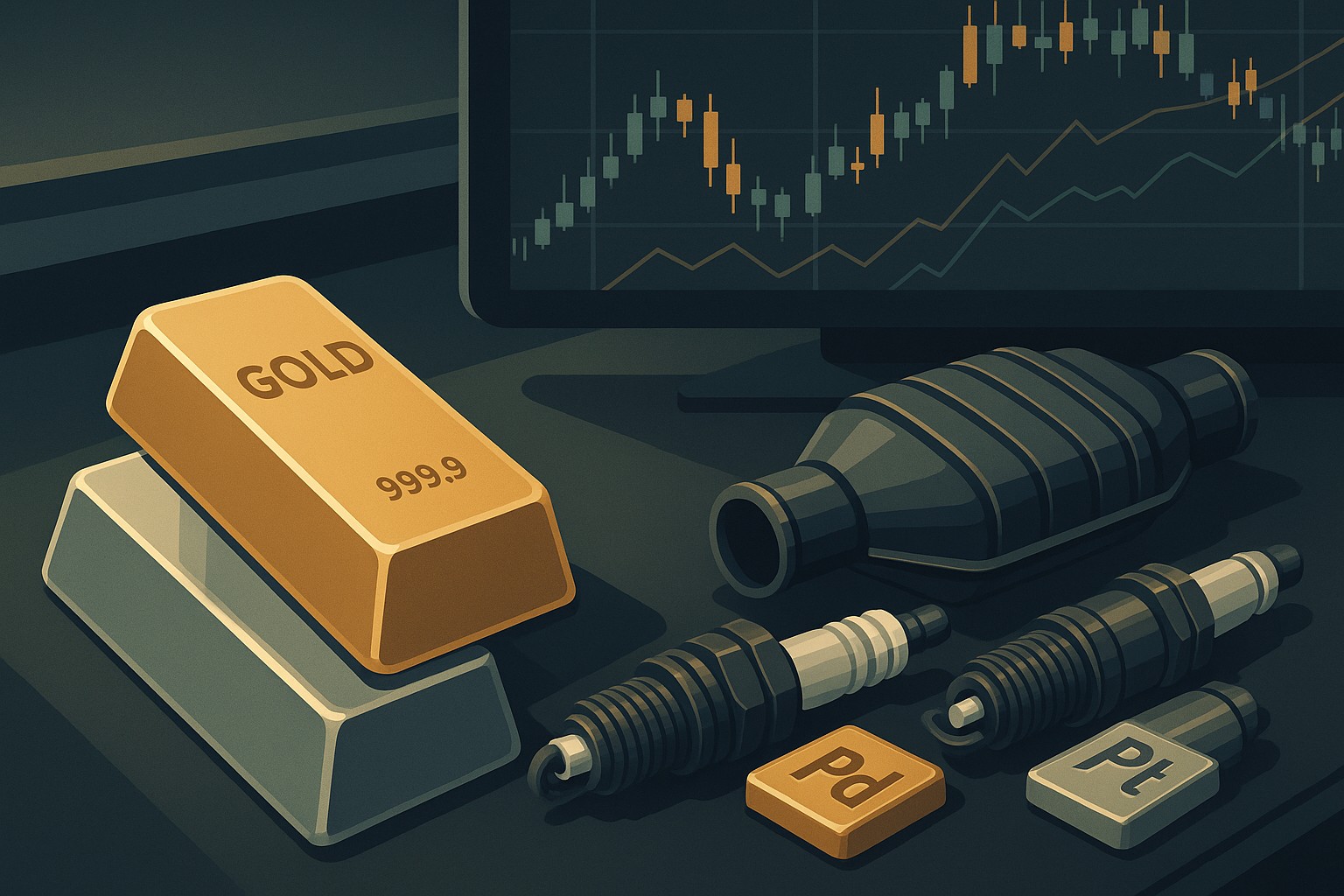
While gold and silver capture attention as stores of value, platinum and palladium are the engines of industry. They belong to the Platinum Group Metals (PGMs) - a family of six elements known for their high melting points, corrosion resistance, and unmatched catalytic ability.
But here’s where they stand apart:
- Gold represents safety and monetary preservation.
- Silver bridges investment and industrial use.
- Platinum and Palladium, however, are industrial-first metals - their prices move less on investor sentiment and more on manufacturing demand, supply shocks, and technological shifts.
In other words, while gold reacts to inflation or interest rates, platinum and palladium respond to factory floors, car production, and clean energy policies. They are metals with a pulse that beats to the rhythm of the global economy.
The Automotive Core: Where Cycles Begin
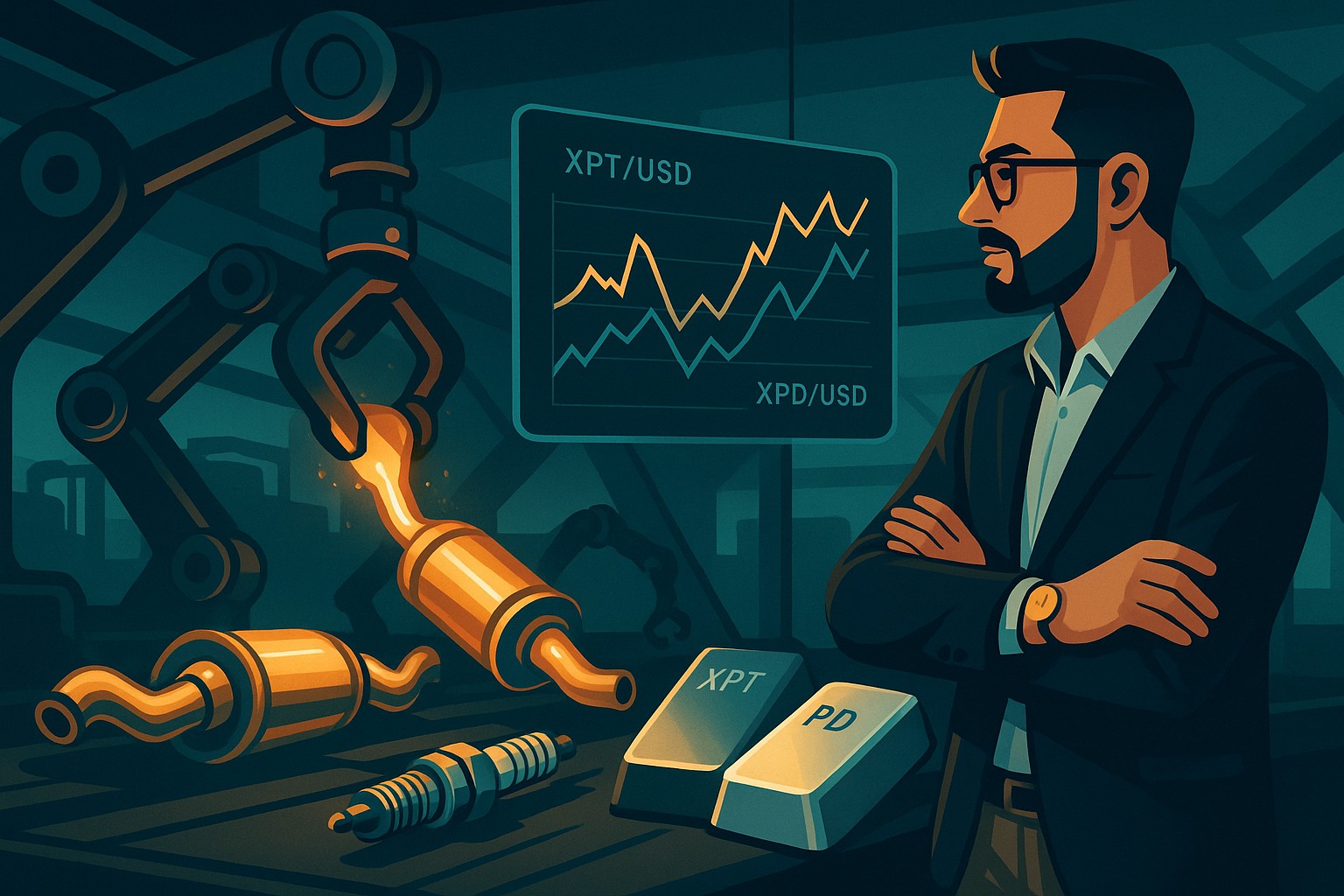
The majority of both platinum and palladium demand comes from automotive catalytic converters - devices that reduce harmful emissions.
- Platinum works best in diesel engines, converting pollutants efficiently.
- Palladium dominates in gasoline engines, offering higher catalytic activity.
As countries push for tighter emission standards, both metals became indispensable - until economic tides started to shift. When diesel cars lost popularity after emission scandals, platinum demand collapsed, while palladium soared to record highs above $1,750+/oz.
But now, the cycle is reversing again. Automakers are quietly substituting cheaper platinum for costly palladium in catalytic converters - igniting a comeback narrative that few retail traders are watching.
Platinum’s Rebound Story: From Underdog to Contender

For years, platinum was the forgotten metal - underperforming gold, silver, and palladium alike.
But that narrative is shifting fast.
Why Platinum is Rising Again
- Substitution Advantage: Automakers are replacing palladium with platinum due to its cost-effectiveness without sacrificing efficiency.
- Hydrogen Revolution: Platinum is vital in hydrogen fuel cells, acting as the core catalyst that converts hydrogen into electricity.
- Supply Strains: About 70% of platinum comes from South Africa, where frequent mining disruptions and energy shortages squeeze production.
These overlapping forces are rebalancing global supply and demand. For traders, it means volatility spikes, liquidity gaps, and clean structure - prime setups for SMC entries built around institutional re-accumulation zones.
Palladium’s Volatility: The Metal on Edge
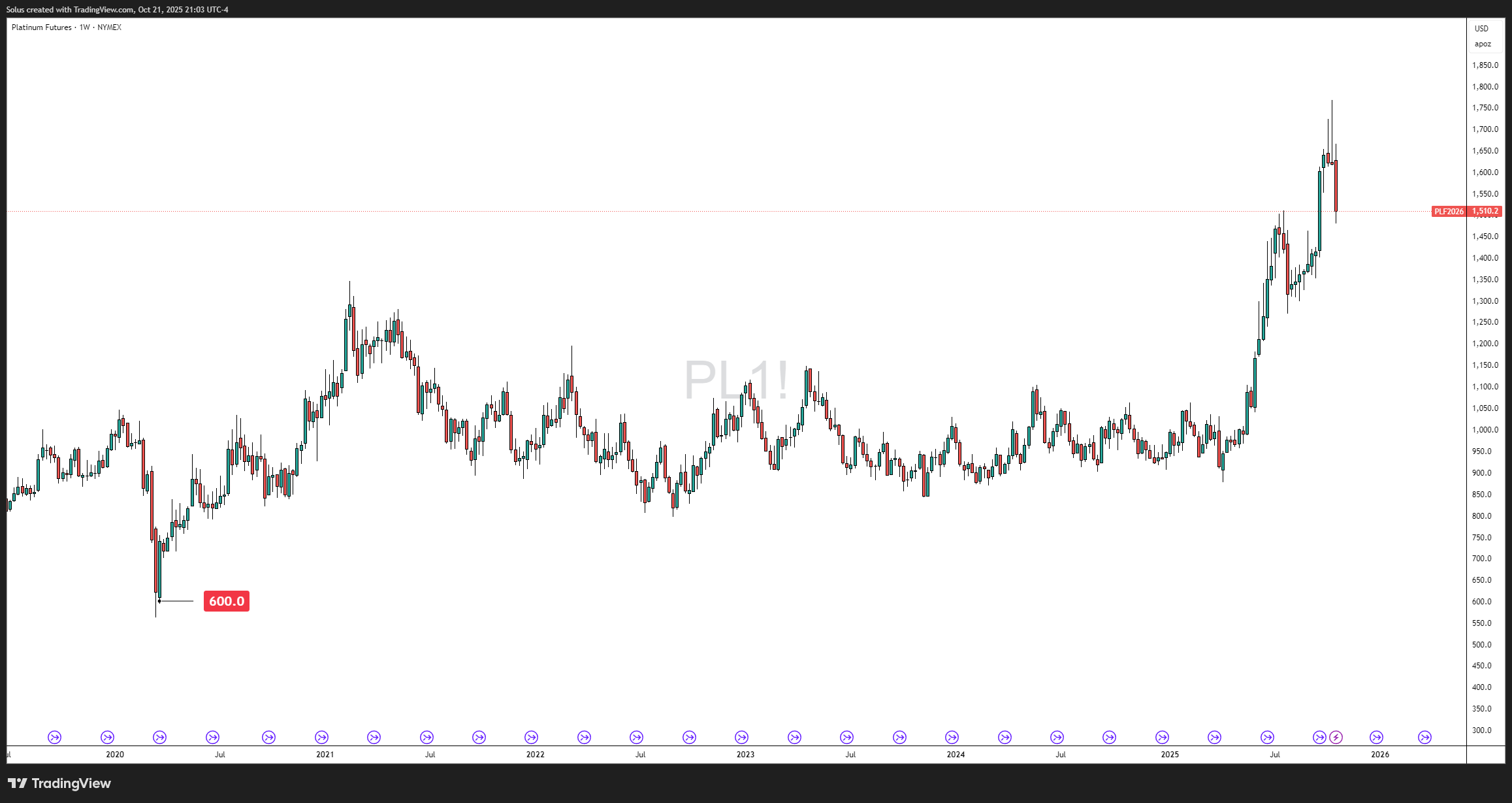
If platinum is the quiet reformer, palladium is the risk-taker.
It went from under $500 in 2016 to over close to $1,800 by 2025 - outpacing most major metals. Its rally was powered by:
- Tight global supply dominated by Russia (≈40% of production)
- Surging gasoline vehicle sales post-pandemic
- Tougher emission regulations worldwide
But as electric vehicles gain traction and substitution accelerates, palladium faces a long-term headwind. Prices have since cooled, creating wider range-bound structures perfect for liquidity sweeps and mean reversion trades.
For SMC traders, this is where opportunity hides - not in chasing breakouts, but in mapping where institutional flow accumulates after emotional market overreactions.
How They Differ from Gold and Silver
Platinum and palladium behave fundamentally differently from traditional precious metals.
| Aspect | Gold & Silver | Platinum & Palladium |
|---|---|---|
| Primary Driver | Monetary & speculative | Industrial & cyclical |
| Volatility Source | Investor sentiment | Supply disruptions & industrial demand |
| Main Users | Investors, jewelry buyers | Automakers, manufacturers |
| Reaction to Inflation | Positive correlation (hedge) | Mixed; depends on manufacturing cycle |
| Geographic Supply | Global & diversified | Concentrated in South Africa & Russia |
| Liquidity | High (especially gold) | Low to medium; thin markets |
This distinction is crucial for traders.
While gold and silver often move inverse to the U.S. dollar or interest rates, platinum and palladium move in sync with global manufacturing health.
So when traders see risk sentiment improve - equities rallying, oil prices climbing, or China’s stimulus announcements - it’s often industrial metals, not gold, that lead the next wave of opportunity.
The Supply Chessboard: South Africa and Russia

The geographic concentration of platinum and palladium makes them incredibly vulnerable to geopolitical risk.
- South Africa produces most of the world’s platinum and a significant share of palladium. However, power shortages and labor strikes frequently interrupt output.
- Russia, the top palladium exporter, faces sanctions and logistical constraints that can choke supply almost overnight.
This limited supply chain is both a curse and a catalyst. For traders, every disruption can create a sudden liquidity imbalance, causing price displacement - a telltale signature of institutional repositioning.
These conditions make SMC setups - Fair Value Gaps (FVGs), Market Structure Shifts (MSS), and liquidity sweeps - especially effective for spotting where price may rebalance before its next expansion phase.
How to Trade Platinum and Palladium with Smart Money Concepts
Unlike gold, these metals are thinner in volume - meaning fewer retail players and cleaner footprints of Smart Money. Here’s how to align your SMC strategy:
1. Use a Top-Down Approach
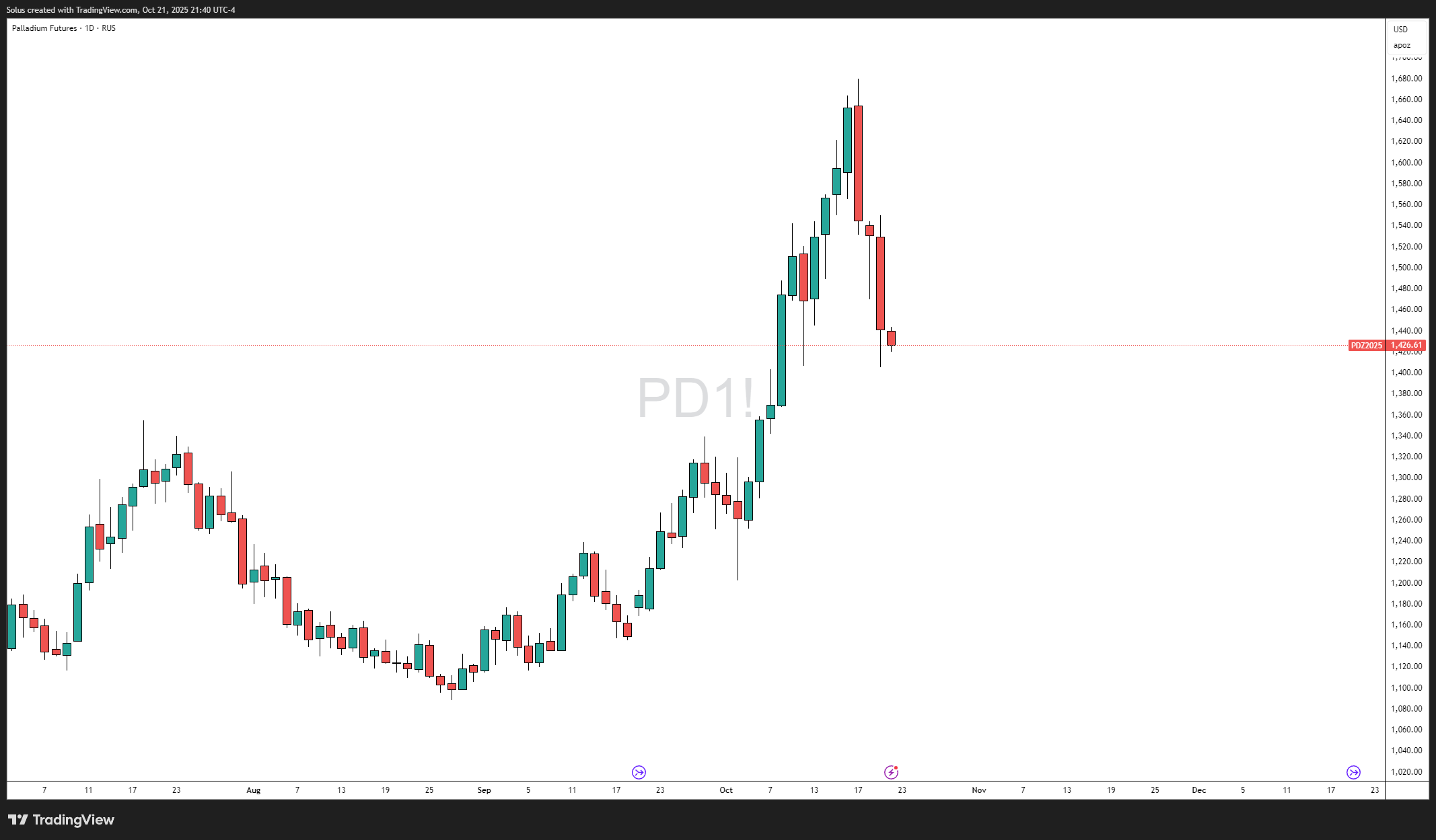
Start with H4 or Daily to identify swing highs and lows. Platinum and palladium often sweep prior liquidity before making impulsive moves.
2. Look for Volume Gaps
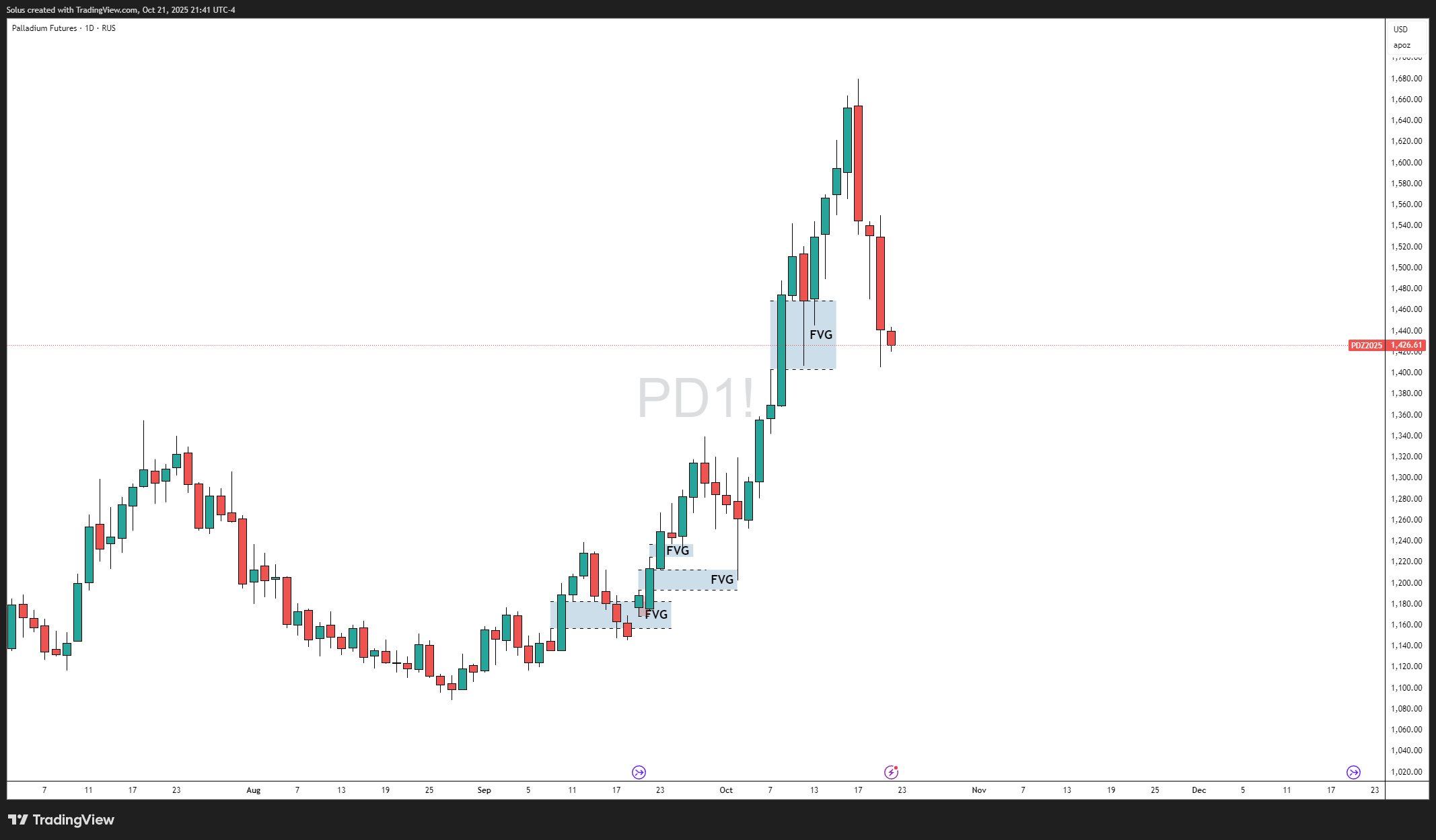
Because of thin trading, volume imbalances or fair value gaps often appear clearly - perfect for re-entry zones.
3. Wait for Confirmation
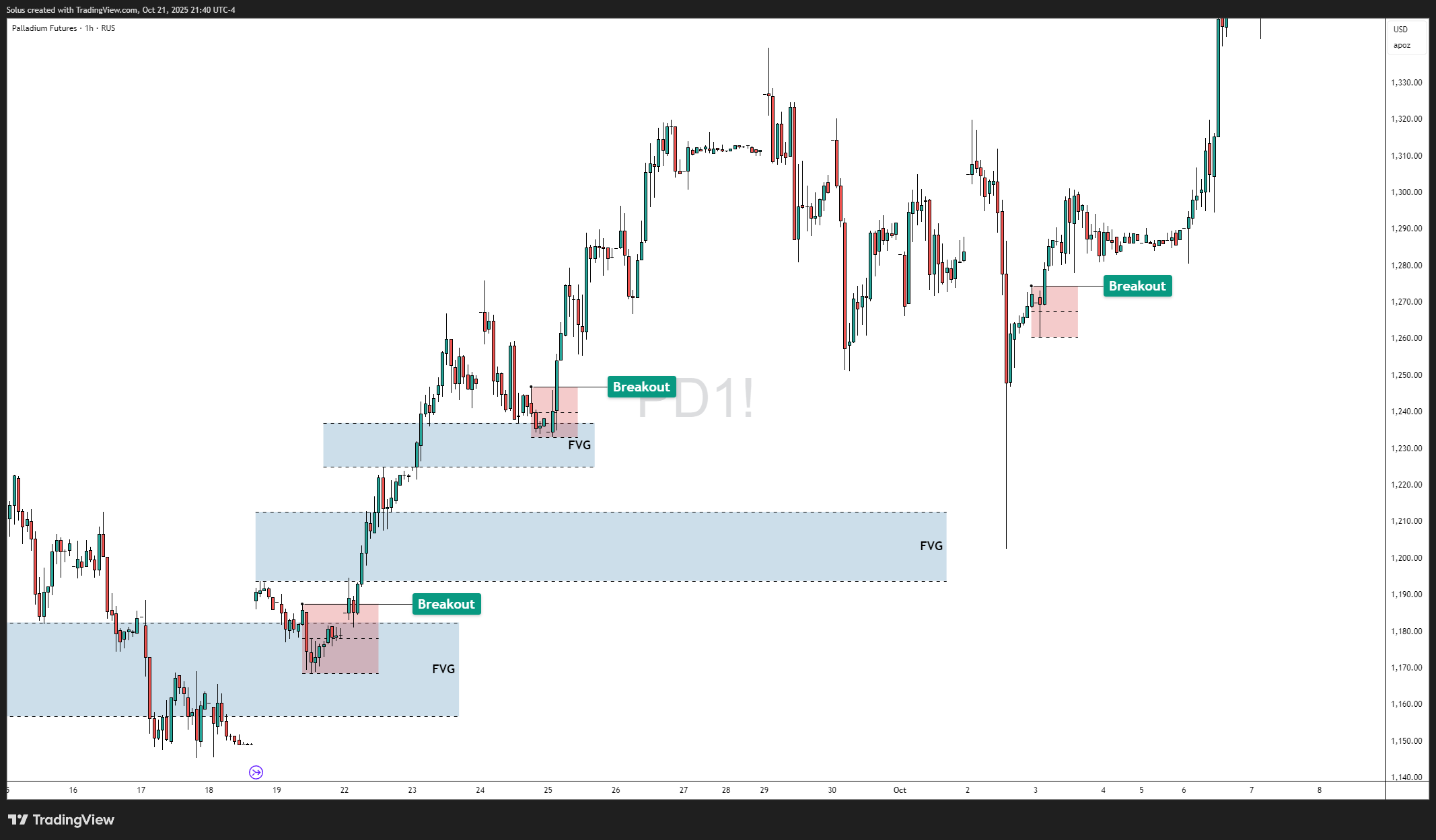
After a sweep, confirm direction through MSS (Market Structure Shift) and only then plan entries within discount or premium FVGs.
4. Incorporate Fundamentals
Align technical setups with real-world catalysts - mine shutdowns, energy shortages, or substitution news. Structure moves, but fundamentals ignite it.
Real-Life Analogy: The Hidden Engine Beneath the Hood
If gold is the crown and silver the mirror, platinum and palladium are the engine under the hood - unseen, yet essential.
Their cycles mirror that of the broader economy. When manufacturing thrives, demand ignites. When innovation shifts - like electric or hydrogen vehicles - they adapt and lead again in new forms.
They’re not driven by fear like gold, but by function and necessity. And for the strategic trader, that makes them uniquely predictable once you understand their rhythm.
Challenge for the Week: Track the Industrial Rotation
Your task this week:
- Plot XPT/USD and XPD/USD on the daily chart.
- Identify which metal is showing early signs of trend reversal.
- Note how news on EV adoption, hydrogen tech, or Russian sanctions coincide with structural shifts.
- Observe liquidity sweeps at swing highs or lows following major headlines - these are institutional footprints waiting to be retraced.
The goal? Not just to predict, but to understand how industrial demand translates to price structure.
Final Thoughts: The Quiet Comeback of Industrial Royalty
Platinum and palladium don’t glitter with hype - they hum with purpose.
They may not sit in vaults or jewelry boxes like gold and silver, but they sit inside engines, converters, and technologies that move the world. That’s their quiet power.
As the global economy pivots toward cleaner energy and smarter mobility, these metals will play pivotal roles - not just in industry, but in trading opportunities.
For the SMC trader, this is where patience meets precision. Watch how liquidity behaves around these metals; study how structure shifts with every industrial change.
Because in a world obsessed with gold’s shine, the true brilliance often lies in the shadows - in the steady hum of platinum and palladium, the metals that power progress.
FAQs
What makes platinum and palladium unique from gold and silver?
They’re primarily driven by industrial demand, especially automotive and clean energy sectors, whereas gold and silver are more investment-driven.
Are these metals suitable for retail traders?
Yes, but expect thinner liquidity. Manage smaller position sizes and prioritize higher timeframes for cleaner structures.
Why is platinum making a comeback?
Due to palladium substitution, hydrogen energy expansion, and recurring supply disruptions in South Africa.
Is palladium still relevant with EVs rising?
Yes - though EVs reduce catalytic converter demand, palladium remains essential for hybrid vehicles and other industrial catalysts.
Start Practicing with Confidence - Risk-Free!
- Trade forex, indices, gold, and more
- Access ACY, MT4, MT5, & Copy Trading Platforms
- Practice with zero risk
It’s time to go from theory to execution - risk-free.
Create an Account. Start Your Free Demo!
Check Out My Contents:
Strategies That You Can Use
Looking for step-by-step approaches you can plug straight into the charts? Start here:
- How To Trade & Scalp Indices at the Open Using Smart Money Concepts (SMC)
- How to Trade Breakouts Effectively in Day Trading with Smart Money Concepts
- Complete Step-by-Step Guide to Day Trading Gold (XAU/USD) with Smart Money Concepts (SMC)
- The Power of Multi-Timeframe Analysis in Smart Money Concepts (SMC)
- Forex Trading Strategy for Beginners
- Mastering Candlestick Pattern Analysis with the SMC Strategy for Day Trading
- How to Use Fibonacci to Set Targets & Stops (Complete Guide)
- RSI Divergence Trading Strategy for Gold: How to Identify and Trade Trend Reversals
- Stochastics Trading Secrets: How to Time Entries in Trending Markets using Stochastics
- Gold Trading Stochastics Strategy: How to Trade Gold with 2R - 3R Targets
- RSI Hidden Divergence Explained: How to Spot Trend Continuations Like a Pro
- Moving Averages Trading Strategy Playbook
- Mastering Fibonacci Trading Psychology - Trusting the Levels, Managing the Mind
- Mastering Price Action at Key Levels - How to Spot, Trade, and Win at the Most Crucial Zones
- Mastering Retests: How to Enter with Confirmation After a Breakout
Indicators / Tools for Trading
Sharpen your edge with proven tools and frameworks:
- The Ultimate Guide to Risk Management in Trading - A Complete Compilation for 2025
- Moving Averages Trading Strategy Playbook
- How to Think Like a Price Action Trader
- Mastering Fibonacci Trading Psychology - Trusting the Levels, Managing the Mind
How To Trade News
News moves markets fast. Learn how to keep pace with SMC-based playbooks:
- Why Smart Money Concepts Work in News-Driven Markets - CPI, NFP, and More
- How to Trade NFP Using Smart Money Concepts (SMC) - A Proven Strategy for Forex Traders
- How to Trade CPI Like Smart Money - A Step-by-Step Guide Using SMC
Learn How to Trade US Indices
From NASDAQ opens to DAX trends, here’s how to approach indices like a pro:
- How to Start Trading Indices and Get into the Stock Market with Low Capital (2025 Guide)
- Best Indices to Trade for Day Traders | NASDAQ, S&P 500, DAX + Best Times to Trade Them
- How To Trade & Scalp Indices at the Open Using Smart Money Concepts (SMC)
- NAS100 - How to Trade the Nasdaq Like a Pro (Smart Money Edition)
How to Start Trading Gold
Gold remains one of the most traded assets - here’s how to approach it with confidence:
- How to Swing Trade Gold (XAU/USD) Using Smart Money Concepts: A Simple Guide for Traders
- Complete Step-by-Step Guide to Day Trading Gold (XAU/USD) with Smart Money Concepts (SMC)
- The Ultimate Guide to Backtesting and Trading Gold (XAU/USD) Using Smart Money Concepts (SMC)
- Why Gold Remains the Ultimate Security in a Shifting World
- How to Exit & Take Profits in Trading Gold Like a Pro: Using RSI, Range Breakdowns, and MAs as Your Confluence
How to Trade Japanese Candlesticks
Candlesticks are the building blocks of price action. Master the most powerful ones:
- Mastering the Top Japanese Candlesticks: The Top 5 Candlesticks To Trade + Top SMC Candlestick Pattern
- How to Trade Candlestick Patterns with High Probability: A Complete Guide for Beginners
- The Top Japanese Candlestick Guide: What is an Engulfing Pattern and How to Trade It?
- Piercing Pattern Candlestick Explained: How to Trade It - Step-By-Step Guide
- Morning & Evening Star Candlestick Patterns - How to Trade Market Reversals with Confidence
How to Start Day Trading
Ready to go intraday? Here’s how to build consistency step by step:
- 5 Steps to Start Day Trading: A Strategic Guide for Beginners
- 8 Steps How to Start Forex Day Trading in 2025: A Beginner’s Step-by-Step Guide
- 3 Steps to Build a Trading Routine for Consistency and Discipline - Day Trading Edition
- The Ultimate Guide to Understanding Market Trends and Price Action
- Trading with Momentum: The Best Trading Session to Trade Forex, Gold and Indices
Swing Trading 101
- Introduction to Swing Trading
- The Market Basics for Swing Trading
- Core Principles of Swing Trading
- The Technical Foundations Every Swing Trader Must Master
- Swing Trader’s Toolkit: Multi-Timeframe & Institutional Confluence
- The Psychology of Risk Management in Swing Trading
- Swing Trading Concepts To Know In Trading with Smart Money Concepts
- Becoming a Consistent Swing Trader: Trading Structure & Scaling Strategy
Learn how to navigate yourself in times of turmoil
Markets swing between calm and chaos. Learn to read risk-on vs risk-off like a pro:
- How to Identify Risk-On and Risk-Off Market Sentiment: A Complete Trader’s Guide
- How to Trade Risk-On and Risk-Off Sentiment - With Technical Confirmation
- The Ultimate Guide to Understanding Market Trends and Price Action
Want to learn how to trade like the Smart Money?
Step inside the playbook of institutional traders with SMC concepts explained:
- Why Smart Money Concepts Work: The Truth Behind Liquidity and Price Action
- Mastering the Market with Smart Money Concepts: 5 Strategic Approaches
- Understanding Liquidity Sweep: How Smart Money Trades Liquidity Zones in Forex, Gold, US Indices
- The SMC Playbook Series Part 1: What Moves the Markets? Key Drivers Behind Forex, Gold & Stock Indices
- The SMC Playbook Series Part 2: How to Spot Liquidity Pools in Trading - Internal vs External Liquidity Explained
- Fair Value Gaps Explained: How Smart Money Leaves Footprints in the Market
- Accumulation, Manipulation, Distribution: The Hidden Cycle That Runs Every Market
- Institutional Order Flow - Reading the Market Through the Eyes of the Big Players
- London Session Trading Secrets: How Smart Money Sets the High & Low of the Day
- Mastering the New York Session - Smart Money Concepts Guide
Master the World’s Most Popular Forex Pairs
Forex pairs aren’t created equal - some are stable, some are volatile, others tied to commodities or sessions.
- The Top 5 All-Time Best Forex Pairs to Trade
- Top Forex Pairs Beyond the Big Five
- EUR/USD: The King of Forex
- USD/JPY: The Fast Mover
- GBP/USD: The Volatile Cable
- AUD/USD: The Commodity Currency
- USD/CAD: The Oil-Backed Pair
- GBP/JPY: How to Trade The Beast
- Asian & London Session Secrets
- Mastering the New York Session
Metals Trading
- Metals Trading: Why Gold and Metals Are Rising Again
- Silver Trading: The Underdog with Dual Identity
- Gold vs Silver: Institutional Demand Breakdown Explained
Stop Hunting 101
If you’ve ever been stopped out right before the market reverses - this is why:
- Stop Hunting 101: How Swing Highs and Lows Become Liquidity Traps
- Outsmarting Stop Hunts: The Psychology Behind the Trap
- How to Lessen Risk From Stop Hunts in Trading
- How Stop Hunts Trigger Revenge Trading - Breaking the Pain Cycle
- How to Accept Stop Hunts Without Losing Discipline - Shifting From Frustration to Focus
Trading Psychology
Mindset is the deciding factor between growth and blowups. Explore these essentials:
- The Mental Game of Execution - Debunking the Common Trading Psychology
- Managing Trading Losses: Why You Can Be Wrong and Still Win Big in Trading
- The Hidden Threat in Trading: How Performance Anxiety Sabotages Your Edge
- Why 90% of Retail Traders Fail Even with Profitable Trading Strategies
- Top 10 Habits Profitable Traders Follow Daily to Stay Consistent
- Top 10 Trading Rules of the Most Successful Traders
- Top 10 Ways to Prevent Emotional Trading and Stay Disciplined in the Markets
- Why Most Traders Fail - Trading Psychology & The Hidden Mental Game
- Emotional Awareness in Trading - Naming Your Triggers
- Discipline vs. Impulse in Trading - Step-by Step Guide How to Build Control
- Trading Journal & Reflection - The Trader’s Mirror
- Overcoming FOMO & Revenge Trading in Forex - Why Patience Pays
- Risk of Ruin in Trading - Respect the Math of Survival
- Identity-Based Trading: Become Your Trading System for Consistency
- Trading Psychology: Aligning Emotions with Your System
- Mastering Fear in Trading: Turn Doubt into a Protective Signal
- Mastering Greed in Trading: Turn Ambition into Controlled Growth
- Mastering Boredom in Trading: From Restless Clicking to Patient Precision
- Mastering Doubt in Trading: Building Confidence Through Backtesting and Pattern Recognition
- Mastering Impatience in Trading: Turn Patience Into Profit
- Mastering Frustration in Trading: Turning Losses Into Lessons
- Mastering Hope in Trading: Replacing Denial With Discipline
- When to Quit on Trading - Read This!
- The Math of Compounding in Trading
- Why Daily Wins Matter More Than Big Wins
- Scaling in Trading: When & How to Increase Lot Sizes
- Why Patience in Trading Fuels the Compounding Growth
- Step-by-Step Guide on How to Manage Losses for Compounding Growth
- The Daily Habits of Profitable Traders: Building Your Compounding Routine
- Trading Edge: Definition, Misconceptions & Casino Analogy
- Finding Your Edge: From Chaos to Clarity
- Proving Your Edge: Backtesting Without Bias
- Forward Testing in Trading: How to Prove Your Edge Live
- Measuring Your Edge: Metrics That Matter
- Refining Your Edge: Iteration Without Overfitting
- The EDGE Framework: Knowing When and How to Evolve as a Trader
- Scaling Your Edge: From Small Account to Consistency
Market Drivers
- Central Banks and Interest Rates: How They Move Your Trades
- Inflation & Economic Data: CPI Trading Strategy and PPI Indicator Guide
- Geopolitical Risks & Safe Havens in Trading (Gold, USD, JPY, CHF)
- Jobs, Growth & Recession Fears: NFP, GDP & Unemployment in Trading
- Commodities & Global Trade: Oil, Gold, and Forex Explained
- Market Correlations & Intermarket Analysis for Traders
Risk Management
The real edge in trading isn’t strategy - it’s how you protect your capital:
- Mastering Risk Management: Stop Loss, Take Profit, and Position Sizing
- Why Risk Management Is the Only Edge That Lasts
- How Much Should You Risk per Trade? (1%, 2%, or Less?)
- The Ultimate Risk Management Plan for Prop Firm Traders - Updated 2025
- Mastering Position Sizing: Automate or Calculate Your Risk Like a Pro
- Martingale Strategy in Trading: Compounding Power or Double-Edged Sword?
- How to Add to Winners Using Cost Averaging and Martingale Principle with Price Confirmation
Suggested Learning Path
If you’re not sure where to start, follow this roadmap:
- Start with Trading Psychology → Build the mindset first.
- Move into Risk Management → Learn how to protect capital.
- Explore Strategies & Tools → Candlesticks, Fibonacci, MAs, Indicators.
- Apply to Assets → Gold, Indices, Forex sessions.
- Advance to Smart Money Concepts (SMC) → Learn how institutions trade.
- Specialize → Stop Hunts, News Trading, Turmoil Navigation.
This way, you’ll grow from foundation → application → mastery, instead of jumping around randomly.
Follow me for more daily market insights!
Jasper Osita - LinkedIn - FXStreet - YouTube
This content may have been written by a third party. ACY makes no representation or warranty and assumes no liability as to the accuracy or completeness of the information provided, nor any loss arising from any investment based on a recommendation, forecast or other information supplies by any third-party. This content is information only, and does not constitute financial, investment or other advice on which you can rely.
Try These Next
4 Powerful Tactics to Overcome the Most Costly Forex Mistakes
How to Master MT4 & MT5 - Tips and Tricks for Traders
The Importance of Fundamental Analysis in Forex Trading
Forex Leverage Explained: Mastering Forex Leverage in Trading & Controlling Margin
The Importance of Liquidity in Forex: A Beginner's Guide
Close All Metatrader Script: Maximise Your Trading Efficiency and Reduce Stress
Best Currency Pairs To Trade in 2025
Forex Trading Hours: Finding the Best Times to Trade FX
MetaTrader Expert Advisor - The Benefits of Algorithmic Trading and Forex EAs
Top 5 Candlestick Trading Formations Every Trader Must Know















